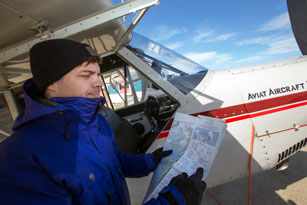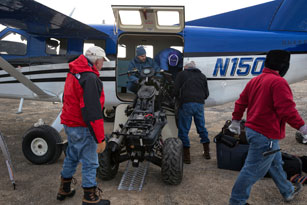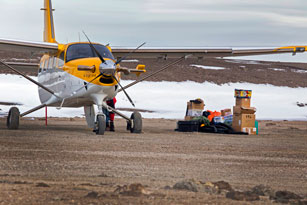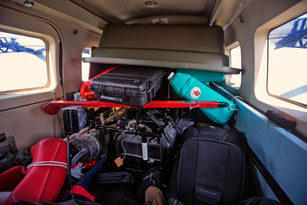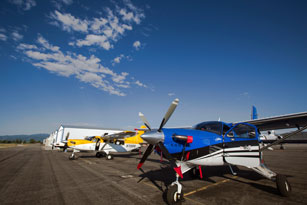Loaded near maximum weight, a flight of two Quest Kodiaks cruised in the Arctic summer sky over vast swaths of barren tundra and sea ice fraught with history. The steady thrum of their Pratt & Whitney turboprops was reassuring, although the pilots were inspired more than once to speculate whether the sea ice below could hold 7,000 pounds of airplane.
If it ever came to that, a safe landing would only mark the beginning of a struggle to survive in a land that has seen many fail.
In 1845, Sir John Franklin set sail in command of two British warships to chart the Northwest Passage winding through Canada’s Arctic islands. They never returned. Rescue attempts began three years later, and lasted for years. In August 1852, HMS Resolute launched her second such voyage, now the flagship of five ships looking for Franklin and his crew—they found graves, and a note, but little else—and also hoping to find two of the other ships previously sent in search of Franklin.
A year later, in August 1853, an unexpected summer cold front locked Resolute in drifting sea ice, and the crew hunkered down for winter. The ice did not relent the following spring; Capt. Henry Kellett draped a British flag over his wardroom chair and led his crew on a successful hard march across the ice to Beechey Island. It is a desolate spit of snowy rock just off the shore of the much larger (and equally desolate) Devon Island, roughly twice the size of Maryland, and remains uninhabited in the present day.
Resolute was not lost forever: an American whaling ship found the three-masted barque drifting, as shipshape as she had been left, in 1855, and Resolute was returned to Britain. (By way of thanks, the British government had timbers from Resolute made into three massive desks, one of which sits today in the Oval Office.)
This past July, a month shy of 160 years after Resolute was snared by ice, two American pilots and a small crew seeking to simulate a mission to Mars departed Idaho, bound for Devon Island—a course that would take the aircraft within a few miles of Beechey Island.
Even today, not everything that goes to the Arctic comes back, a point driven home by an airplane wreck on Devon Island, half covered in snow, photographed by the pilot of an Aviat Husky traversing the Arctic who was himself forced by lowering clouds and icing to divert to Resolute Bay—in July.


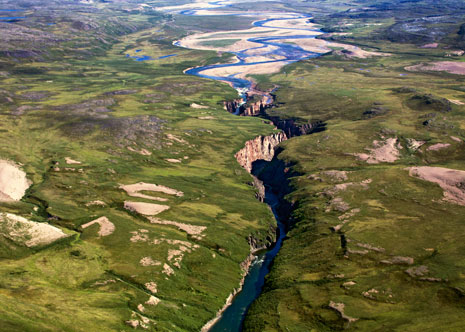
Named for the ship, Resolute Bay is home to a small clutch of permanent residents, and is the modern hub of North Pole exploration. Its residents, many of them Inuit Eskimos, endure winters of endless darkness, and hunt much of what they eat. Satellite dishes point to the horizon, and the nearest alternate airport (most people and supplies come and go by air, although there is an annual sealift) is 200 miles away.
Those miles are full of eye-popping beauty, including glaciers, icebergs, miles of trackless tundra—and thousands of polar bears, although they can be hard to spot in the snow.
‘If you see a bear…’
On the ramp at Yellowknife, the capital of Canada’s Northwest Territories and the northern limit for high-rise buildings and avgas, Matrix Aviation Solutions loaded the Kodiaks on July 9 for the journey to Devon Island. The staff maneuvered heavy equipment with practiced ease, sliding steel forks loaded with heavy gear into the nearly $2 million aircraft with a delicate touch. At the wheel of a forklift, Joshua Brown—a self-described “bush rat” with six years of high Arctic camp life under his belt—offered advice to Arctic novices: “If you see a bear, and then you don’t see it, arm yourself,” Brown said with great earnestness, appearing concerned by the inexperience of northbound passengers and pilots. “He’s stalking you.”
At the Devon Island camp, the team found that a chunk of heavy plastic, used to catch any leaks from the fuel drums stored there, had been ripped away. The discarded hunk was found nearby, bearing the marks of polar bear claws and teeth. Expedition leader Joseph E. Palaia IV kept it as an “interesting souvenir.” Particular care was taken to ensure that bullets were on board, and at least one rifle per airplane.
The history of Resolute Bay and its surroundings is instructive: one should not venture here unprepared; even summer months can harbor danger; and rescue, if it ever comes, can take a while. The weather can go from good to awful very quickly. It can snow in any month, and thick summer fog can ground flights for weeks. Prudent pilots carry food, water, shelter, a stove (there’s precious little wood to burn), and a gun—enough to survive a couple of weeks without assistance.
“My teams, when they go in the field, those kind of numbers are what we talk about,” said Barry Gaulton, general manager of northern operations for ATCO Structures & Logistics, watching the aircraft loading on the ramp at Yellowknife. Gaulton, who has spent decades working in Arctic aviation, said that while two weeks of supplies might be too much for smaller aircraft, it is best to be as well-prepared as useful load allows.
The Kodiaks, both owned by military veterans—a doctor, Richard Sugden, and retired investment banker Richard Spencer—were loaded with supplies and equipment, including a powerful generator and an ATV. This was an advance team preparing the way for an ambitious effort to station volunteers on Devon Island—about 500 miles north of the Arctic Circle—for a solid year. Gaulton, who has been on Devon Island in winter, said the temperatures can plunge 60 degrees below zero, with winds that make it “colder than anyone wants to remember.”
‘It sounded kind of neat’
Spencer, a retired U.S. Marine Corps captain who flew both fixed-wing and helicopters, and later started a helicopter service in San Francisco before going to work on Wall Street, said the chance to fly in the high Arctic was the main reason he volunteered his time, fuel, and Kodiak. “You crawl to the edge and look over the side…it’s good for you,” Spencer said. “It’s great to do it once.”
Spencer had been recruited by his friend, Sugden, a fellow Kodiak owner who was in turn recruited by Barry Stott, who donated a significant (although unspecified) sum to support The Mars Society’s bid for the first year-round human habitation of Devon Island attempted to date.
“I think that launching man out into the stars is absolutely the most important thing that we could be doing,” Stott said. “Going to Mars is just the first step.”
The Mars Society grew from seeds of frustration, after a plan to put humans on the planet—and bring them back—at a fraction of the cost of contemporary estimates drew initial enthusiasm within NASA in the early 1990s, then was dropped. Robert Zubrin, co-creator of the Mars Direct mission, intended to make the trip practical by using proven technology, and by making fuel on Mars for the return trip; he’s written books on the topic and still chafes at the rejection.
Zubrin founded the nonprofit society in 1998, drawing members from within academia, along with a broader group of dreamers such as Stott, who quoted Buckminster Fuller (who coined the term “spaceship Earth”), speaking of the fragility of our home planet and the need to expand options. Mankind’s destiny calls, Stott said, and this is no time to wait for NASA. “If nobody was doing this, there wouldn’t be any groundswell for putting pressure on the government,” Stott said.
Waiting on Devon Island was, ironically, an empty NASA research camp. Nearly two miles away, across a shallow river of meltwater, is the team’s destination: a two-story fiberglass cylinder, 27 feet across, modeled on the space habitat that Zubrin envisioned rocketing to Mars. The society raised $1.3 million to build and install it a decade ago, and has since fielded several research teams to occupy it for weeks or months at a time, though never through a winter.
The mission in July was to supply the station, dubbed the Flashline Mars Arctic Research Station for an erstwhile sponsor, and verify that it remains habitable after four years of dormancy. Spencer and Sugden, meanwhile, volunteered primarily for the rare chance to visit the top of the world, just 800 miles south of the geographic North Pole.
“It sounded kind of neat,” Spencer said.
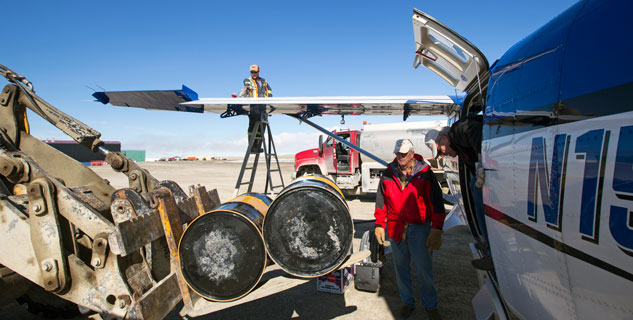
‘It’s just the weather’
Miles rolled by slowly, the Kodiaks cruising just shy of 160 knots, their speed limited by a combination of loading that required a 2.5-degree nose-up pitch for level flight—and the need to conserve fuel. That point had been driven home on the flight from Lethbridge, Alberta, Canada, where the mission cleared customs, to Slave Lake, a fuel stop on the route to Yellowknife.
Spencer’s left tank fuel gauge plunged to zero an hour out of Slave Lake. Spencer had seen this gauge problem twice since he bought the Kodiak in 2011. He had also watched the Lethbridge line crew pump his fuel on the ramp, and knew there should be plenty of fuel remaining. Still, he said, “there’s nothing worse than staring at a red blinking empty fuel indicator.”
Sugden was given permission to close in and visually verify all four fuel caps were in place, demonstrating the value of having a wingman.
North of Edmonton, thick forest stretched to the horizon. The transcontinental network of roads was far behind. Spencer carefully scanned the route ahead for landing options (there were no good ones), occasionally sparing a moment to cycle the pages of the Garmin G1000 to watch the fuel gauge drop and the projected range circle shrink, receding like a slow-motion ocean wave from beyond Slave Lake to well short of it.
“I had plans,” Spencer said, safely on the ground and annoyed by an issue that had bedeviled technicians. “I was in the Marine Corps. I always think the worst, imagining [what can happen]. It’s not pessimism,” he continued, wondering how pilots flying anywhere can afford not to spare some attention to contemplate worst-case scenarios in the interest of being prepared.
North of Yellowknife, crossing the Arctic Circle, the magnetic compass became a cockpit decoration and trees gave way to scrub and tundra. A vast emptiness was broken only occasionally by an isolated outpost. There are widely scattered diamond mines; gold and other metals also are pulled from the ground. A fuel stop in Cambridge Bay was required before pressing on to Resolute Bay. Gaulton had spent 16 years working in Resolute Bay, visiting the North Pole twice during his tenure there.
“Both times were going up to pull people out,” Gaulton said. For all of its remoteness, Resolute Bay—the northernmost location with scheduled air service in North America—can be a busy place. “I had the pleasure of meeting Sir Edmund Hillary and Neil Armstrong. Everybody lands there.”
Back in Yellowknife, Joe Andrews, a Summit Air pilot with years of Arctic aviation under his belt, had pointed out on a map the location of Wilberforce Gorge—one of very few known waterfalls north of the Arctic Circle, where the Hood River makes its final plunge from the North American mainland into the Arctic Sea. It was a scenic highlight of the trip.
“Resolute’s great. It’s just the weather,” said Andrews. Hazards, he said, are generally manageable. “The big one is fuel. As long as you’ve got fuel….”
Sugden and Spencer had done their homework before making the voyage, studying charts and tapping knowledge of pilots like Andrews. “We called a lot of pilots that fly up here and just asked them questions,” Sugden recalled.
The Kodiaks slowed to 60 knots with flaps deployed, approaching a narrow strip of Devon Island dirt that was barely distinguishable from the snow-patched dirt and mud all around it. A rock formation rose just to the right of the final approach, the landing target a patch of mud marked with tire ruts in the midst of rocky terrain. Sugden and Spencer reversed their props as soon as the wheels touched, slowing quickly before the terrain dropped downhill. They had about a thousand feet to work with, more or less.
Relatively few aircraft could (or should) attempt to carry a ton of people and cargo to Devon Island, a place where polar bears roam and summer mud can snare a landing aircraft the way ice snared HMS Resolute, and never let go.
The Kodiaks made several trips to Devon Island, delivering a crew of three, with two more to follow in the coming days. They returned to Yellowknife for more food, supplies, and equipment before fetching the volunteers for the trip back home the following week. They laid the groundwork for a more ambitious mission that Zubrin and the Mars Society hope will begin in the summer of 2014—a scientific enterprise intended to test the ability of humans to operate in a hostile environment and endure the most extreme isolation Earth can offer. The society is working to raise $1 million to support the mission, and recruit volunteers to crew it.
Zubrin said help from pilots is critical—and appreciated: There will be much more to carry, and air charters in the Arctic cost thousands of dollars the nonprofit group does not have. “Pilots can help get us to Mars,” he said.
Email [email protected]
